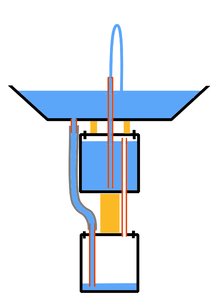Heron's fountain
Heron's fountain is a hydraulic machine invented by the 1st century AD inventor, mathematician, and physicist Heron, also known as Hero of Alexandria.
Heron studied the pressure of air and steam, described the first steam engine, and built toys that would spurt water, one of them known as Heron's fountain. Various versions of Heron's fountain are used today in physics classes as a demonstration of principles of hydraulics and pneumatics.
Construction
Heron's fountain is built as follows:
- Start with a basin, open to the air. Run a pipe from a hole in the bottom of that basin to an airtight air supply container. (Glass flasks are shown here, and serve the purpose well. Cans with airtight lids may also be used.) The air supply container stands significantly below the basin.
- Run another pipe from the top of that container up to the top of the airtight fountain supply container, which is filled with water.
- From the fountain supply container, have a pipe that reaches nearly to the bottom of the container, through the top up to the spout of the fountain. A refinement is to have the spout coming up through the centre of the basin, and the containers may be concealed in a column supporting the basin, as long as the air supply container is lower than the fountain supply container.
- Fill the basin with water.
- The water from the basin flows by gravity into the air supply container. It fills the container, displacing the air.
- The air flows into the fountain supply container, displacing the water, which shoots out higher than the original basin.
- The flow will stop when the fountain supply container is empty (i.e. when the water level drops below the lower end of the outlet pipe).
Motion

Heron's fountain is not a perpetual motion machine.[1] If the nozzle of the spout is narrow, it may play for several minutes, but it eventually comes to a stop. The water coming out of the tube may go higher than the level in any container, but the net flow of water is downward. If, however, the volumes of the air supply and fountain supply containers are designed to be much larger than the volume of the basin, with the flow rate of water from the nozzle of the spout being held constant, the fountain could operate for a far greater time interval.
Its action may seem less paradoxical if it considered as a siphon, but with the upper arch of the tube removed, and the air pressure between the two lower containers providing the positive pressure to lift the water over the arch. The device is also known as Heron's siphon.
The gravitational potential energy of the water which falls a long way from the basin into the lower container is transferred by pneumatic pressure tube (only air is moved upwards at this stage) to push the water from the upper container a short way above the basin.
The fountain can spout (almost) as high above the upper container as the water falls from the basin into the lower container. For maximum effect, place the upper container as closely beneath the basin as possible and place the lower container a long way beneath both.
As soon as the water level in the upper container has dropped so low that the water bearing tube no longer touches the water surface, the fountain stops. In order to make the fountain play again, the air supply container is emptied of water, and the fountain supply container and the basin are refilled. Lifting the water provides the energy required.
Geological phenomena
It is possible that geysers operate via this mechanism, with the distinction that the spouting of the water at the surface occurs discontinuously. Furthermore, unlike Heron's fountain, which requires that the air supply container be manually emptied of water, geysers have an analogous "air supply container" that is steadily heated by geothermal energy. When the water level in the air supply container becomes too high, the geothermal heat flux causes the water to boil off and therefore naturally empty the container of water and replace it with water vapor instead of air.
In popular culture
An example of Heron's fountain, built by Larry Fleinhardt, was featured in the 8th episode (titled "Tabu") of the 4th season of the television show Numb3rs.
Notes
- ↑ Hero's Fountain, physics.kenyon.edu
See also
References
- Brown, Henry T.; "507 Mechanical Movements, Mechanisms and Devices", p. 111; 19th edition 1901.
- Hiscox, Gardner D.; "1800 Mechanical Movements, Devices and Appliances", p. 162; 16th edition published 1926 under the name "Mechanical Movements, Power and Devices".
External links
- R.Ya.Kezerashvili, A.Sapozhnikov. "Magic Fountain", at arxiv.org